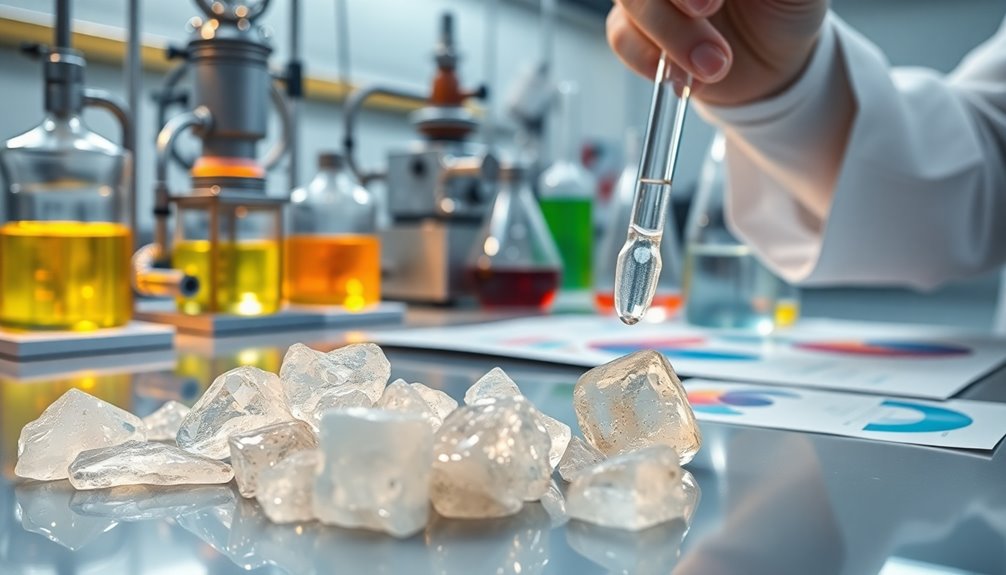Upgrading Fischer-Tropsch waxes into transport fuels involves key catalytic techniques like hydrocracking and hydroisomerization. You'll utilize bifunctional catalysts to enhance fuel quality, ensuring effective conversion of heavy paraffins into lighter fuels. This process not only increases economic viability by monetizing waste products but also boosts environmental sustainability through cleaner feedstocks. As you explore further, you'll discover more about the pivotal role of selectivity and pore topologies in achieving optimal fuel properties.
Key Takeaways
- Hydrocracking efficiently converts heavy paraffinic Fischer-Tropsch waxes into lighter transport fuels like diesel and jet fuel.
- Bifunctional catalysts enhance hydrocracking and hydroisomerization by integrating acidic and hydrogenation functions to improve fuel quality.
- Selective hydroisomerization rearranges long-chain paraffins into desirable structures for high-performance lubricant base oils.
- Autothermal reforming (ATR) technology produces high-purity syngas, crucial for generating high-quality fuels from Fischer-Tropsch waxes.
- Upgrading processes promote environmental sustainability by utilizing cleaner feedstocks and reducing waste, enhancing economic viability in the transport sector.

Upgrading Fischer-Tropsch waxes to transport fuels presents an efficient way to convert high-purity feedstocks into valuable products. By employing hydrocracking, you can transform heavy paraffinic waxes into lighter fuels like diesel and jet fuel, which are essential for modern transportation. This method not only enhances fuel quality but also contributes to environmental sustainability by utilizing cleaner feedstocks. Additionally, the Fischer-Tropsch (FT) Process helps monetize traditionally waste products, further increasing the economic viability of this upgrading approach.
Efficiently converting Fischer-Tropsch waxes into cleaner, high-quality transport fuels enhances sustainability in modern transportation.
Catalysts play a crucial role in these upgrading processes. You'll often find bifunctional catalysts that combine acidic and hydrogenation functions, enabling effective hydrocracking and hydroisomerization. The careful selection of catalysts, particularly those designed with specific pore topologies, ensures selectivity during reactions. This means you can achieve the desired fuel properties while minimizing unwanted byproducts.
For syngas production, autothermal reforming (ATR) technology is frequently used in gas-to-liquid (GTL) plants. This process generates the necessary synthesis gas from Fischer-Tropsch waxes, setting the stage for efficient upgrading. The high purity of these feedstocks, free from sulfur and nitrogen contaminants, makes them particularly attractive. They allow you to produce high-quality fuels and lubricants, enhancing their economic value.
Selective hydroisomerization is another vital catalytic technique. This process rearranges long-chain paraffins into more desirable structures for lubricant base oils, ensuring optimal performance.
Again, the choice of bifunctional catalysts is key, as their dual capabilities cater to both hydrocracking and hydroisomerization needs. The hydrogenation function of these catalysts is integral, as it stabilizes products by saturating unsaturated bonds.
Frequently Asked Questions
What Are Fischer-Tropsch Waxes and Their Origin?
Fischer-Tropsch waxes are synthetic hydrocarbons created through a process that converts carbon monoxide and hydrogen into long-chain hydrocarbons.
You'll find these waxes produced under high pressure during the Fischer-Tropsch synthesis, a key method in natural gas to liquids (GTL) projects.
Their origin lies in the conversion of natural gas, making these waxes a crucial part of producing liquid fuels and other valuable products from gas resources.
What Are the Environmental Impacts of Upgrading Processes?
When you consider the environmental impacts of upgrading processes, you'll notice several key factors.
Emissions from these processes can contribute to air pollution, while water usage strains local resources. The energy required for upgrading increases greenhouse gas emissions, especially if coal's involved.
Additionally, by-products formed during the process may pose further environmental challenges. Overall, the upgrading processes can significantly affect air quality and resource sustainability, necessitating careful management.
How Do Catalytic Techniques Differ From Non-Catalytic Methods?
Imagine a bustling kitchen where chefs use various tools to create gourmet meals. In this scenario, catalytic techniques act like skilled chefs, employing catalysts to enhance reactions and produce refined products efficiently.
Non-catalytic methods, on the other hand, resemble a simple stovetop, relying on heat alone. While both can cook up fuels, catalytic methods excel in efficiency, yield, and environmental benefits, transforming raw ingredients into high-quality transport fuels with finesse.
What Is the Economic Viability of Upgrading Fischer-Tropsch Waxes?
When considering the economic viability of upgrading Fischer-Tropsch waxes, you'll find that factors like technology choice and energy costs play crucial roles.
Access to low-cost electricity can significantly lower production expenses, making the process more appealing. Additionally, the demand for cleaner fuels supports economic sustainability.
Integrating renewable feedstocks can enhance this viability, while financial analyses help you understand the impacts of varying conditions on profitability and market competitiveness.
Are There Any Safety Concerns Associated With These Catalytic Techniques?
"Better safe than sorry." When working with catalytic techniques, you've got to consider several safety concerns.
High temperatures and pressures can create explosion risks, while cobalt catalysts require careful handling to avoid oxidation.
You must also manage water presence, as it can deactivate catalysts.
Additionally, impurities in syngas can poison the catalyst, reducing efficiency.
Staying aware of these issues is crucial for ensuring a safe and effective catalytic process.
Conclusion
In conclusion, upgrading Fischer-Tropsch waxes to transport fuels is like transforming raw clay into fine pottery; it requires skillful catalysts and precise conditions. By employing various catalytic techniques, you can enhance the efficiency and yield of high-quality fuels from these waxes. As the demand for cleaner energy sources grows, mastering these methods not only paves the way for sustainable fuel production but also elevates your role in the journey towards a greener future.








